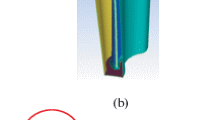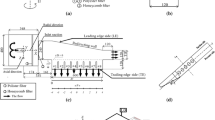Abstract
Some rows of steam and gas turbines, with the exception of the first vanes, operate at the inlet flow conditions created by the upstream turbine stages. In particular, the conditions of the flow at the inlet of a low-pressure turbine vanes (LPT vanes) depend on the upstream high-pressure turbine (HPT). The first stages of the gas turbines are, as a rule, cooled and transonic stages with high power losses; therefore, the nonuniformity of the radial distribution of the angles of flow, the total pressure, and the total temperature may be extremely substantial at the LPT inlet. This leads to increased levels of profile and, especially, secondary losses in the LPT rows. Normally, the LPT vanes have a meridional opening along the inner and outer outlines of the flow path that causes the intensification of the secondary flows and, accordingly, an increase in the secondary losses. To minimize adverse effects on the operation of LPT vanes, such as a nonuniform distribution of the flow parameters at the vane inlet, the meridional opening, and the unfavorable aspect ratio, the width of the blade was increased to decrease the meridional angle of the opening and the three-dimensional design of the vanes was applied to reduce the secondary losses. In particular, variants of the LPT vanes of different spatial configurations were investigated, viz., “reversed bow” vanes, bowed vanes, and leaned vanes in a circumferential direction. The radical change in the vane shape was restricted by the design of the cooling system of the blades that comprises a deflector in the inner hollow of the blade designed to enhance the efficiency of the cooling. As a result, a compromise between the aerodynamic characteristics and the restrictions imposed by the cooling system was found.

















Similar content being viewed by others
Notes
\({{{\text{M}}}_{{is}}} = f\left( {{s \mathord{\left/ {\vphantom {s {\text{P}}}} \right. \kern-0em} {\text{P}}}} \right),\) where s is the curvilinear coordinate along the profile outlines and P is the profile perimeter on the corresponding vane radii.
REFERENCES
M. D. Barringer, K. A. Thole, M. D. Polanka, J. P. Clark, and P. J. Koch, “Migration of combustor exit profiles through high pressure turbine vanes,” J. Turbomach. 131, 021010 (2007). https://doi.org/10.1115/1.2950076
K. S. Hermanson and K. A. Thole, “Effect of nonuniform inlet conditions on endwall secondary flows,” J. Turbomach. 124, 623–631 (2002). https://doi.org/10.1115/1.1505849
K. Funazaki, D. Murakami, and Y. Okamura, “Parametric studies on aerodynamic performance of various types of LP turbine airfoils for aero-engines under the influence periodic wakes and freestream turbulence,” in Proc. ASME Turbo Expo 2019: Turbomachinery Tech. Conf. and Exposition (GT2019), Phoenix, Ariz., June 17–21, 2019 (American Society of Mechanical Engineers, New York, 2019). http://turbo.mech.iwate-u. ac.jp/Fel/papers/GT2019-90408.pdf
M. E. Deich, A. V. Gubarev, G. A. Filippov, and V. Chzhun-Tsi, “A new method of profiling guiding stage grids with low d / l,” Teploenergetika, No. 8, 42–47 (1962).
M. E. Deich, A. E. Zaryankin, G. A. Filippov, and M. F. Zatsepin, “A method of increasing the efficiency of turbine stages with low blade heights,” Teploenergetika, No. 2 (1960).
C. H. Sieverding, “Recent progress in the understanding of basic aspects of secondary flows in turbine blade passages,” J. Eng. Gas Turbines Power 107, 248–257 (1985). https://doi.org/10.1115/1.3239704
B. R. Haller, “Controlled flow turbine stage,” Patent Application No. 0104002.1 (2001) (No. 2359341).
O. P. Sharma, F. C. Kopper, G. M. Stenton, S. S. Magge, F. R. Price, and R. Ni, “A perspective on the use of physical and numerical experiments in the advancement of design technology for axial turbines,” in Proc. XVI Int. Symp. on Air Breathing Engines (ISABE), Cleveland, Oh., Aug. 31 – Sept. 5, 2003 (American Inst. of Aeronautics and Astronautics, Reston, Va., 2003). https://www.worldcat.org/title/xvi-international-symposium-on-air-breathing-engines-isabe-august-31-september-5-2003-renaissance-cleveland-hotel-cleveland-ohio-usa/oclc/54490990
E. Rosa de la Blanco, H. P. Hodson, R. Vazquez, and D. Torre, “Influence of the state of the inlet endwall boundary layer on the interaction between pressure surface separation and endwall flows,” Proc. Inst. Mech. Eng., Part A 217, 433–441 (2003). https://doi.org/10.1243/095765003322315496
A. Granovskiy, M. Kostege, V. Krupa, and S. Rudenko, “Numerical and experimental investigation of two stage gas turbine with bowed vanes,” in Proc. 7th Eur. Conf. on Turbomachinery — Fluid Dynamics and Thermodynamics, Athens, Greece, March 5–9, 2007 (National Technical Univ., 2007), pp. 212–218. https://trimis.ec.europa.eu/ project/support-7th-european-conference-turbomachinery-fluid-dynamics-and-thermodynamics-athens
R. Sigg, M. V. Casey, J. F. Mayer, and N. Surken, “The influence of lean and sweep in a low pressure steam turbine analysis of three stages with a 3D CFD model,” in Proc. ASME Turbo Expo 2008: Power for Land, Sea, and Air, Berlin, Germany, 9–13 June 2008 (American Society of Mechanical Engineers, New York, 2008), Vol. 6: Turbomachinery, Parts A, B, and C, pp. 969–978. https://doi.org/10.1115/GT2008-50161
V. G. Krupa, “Simulation of steady and unsteady viscous flows in turbomachinery,” AGARD Lect. Ser., No. 198, 39 (1994).
T. J. Coakley, “Turbulence modelling for the compressible Navier–Stokes equations,” in Proc. 16th Fluid and Plasmadynamics Conf., Danvers, Mass., July 12–14, 1983 (American Inst. of Aeronautics and Astronautics, Reston, Va., 1983). https://doi.org/10.2514/6.1983-1693
ACKNOWLEDGMENTS
We thank L.I. Bekreneva for the calculations performed using the ANSYS CFX software and A.E. Shunin for the construction of 3D vane models necessary for calculations.
Author information
Authors and Affiliations
Corresponding author
Additional information
Translated by O. Lotova
Rights and permissions
About this article
Cite this article
Afanasiev, I.V., Granovskiy, A.V., Kostege, V.K. et al. Enhancing the Performance of Turbine Rows under Nonuniform Inlet Boundary Conditions. Therm. Eng. 68, 337–346 (2021). https://doi.org/10.1134/S0040601521050013
Received:
Revised:
Accepted:
Published:
Issue Date:
DOI: https://doi.org/10.1134/S0040601521050013




